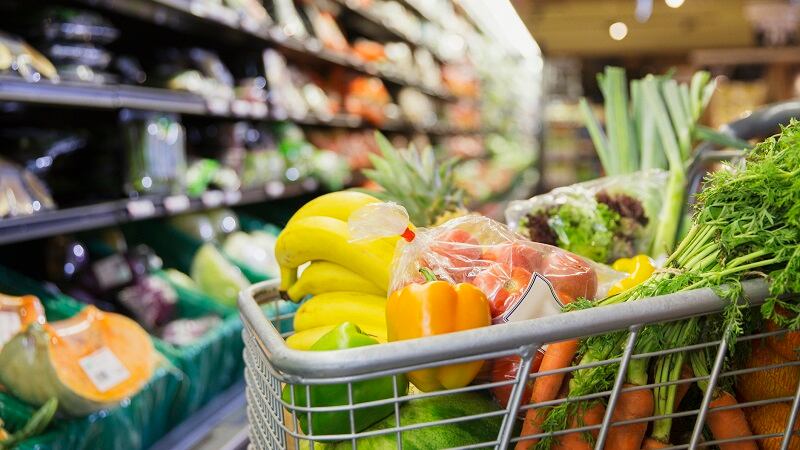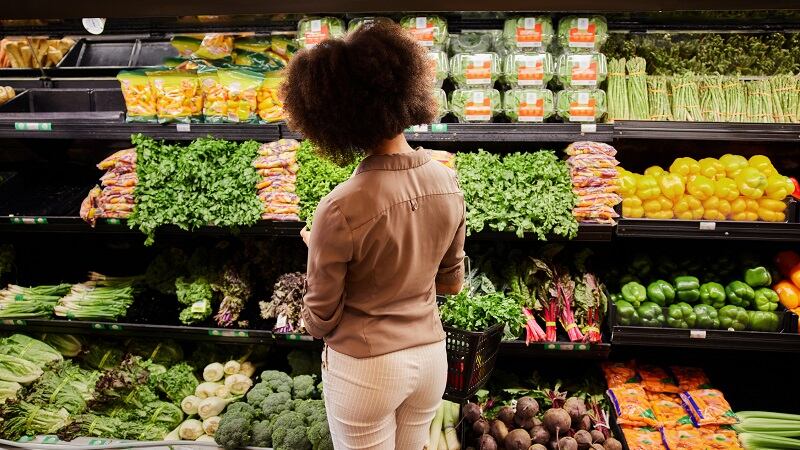In 2023, fresh produce sales, including organic, reached $76.4bn and 41.1bn pounds, according to Circana MULO data for the 52 weeks, ending Oct. 29, 2023. This is compared to $74.6bn and 41.2bn in pounds from a year ago. Tropical and specialty fruit, citrus fruits, and mixed fruits options contributed strong volumes, growing 6.5%, 1.5%, and 0.6%, respectively.
Consumers are also heading into the store more often, but purchasing fewer fresh produce units, similar to other categories. Shoppers spent on average $8.84 on fresh produce and purchase 3.1 units per trip, an increase of 1.1% in dollars and a 1.8% decrease in units, according to Circana data for the same period.
Fresh fruit and vegetable consumption dipped in recent years as shoppers switch to frozen and shelf-stable options.
Fresh produce accounted for 79.3% of fruit and vegetable sales in 2023, declining from 81% in 2021. Frozen vegetables and fruits accounted for 8.9% and shelf-stable by 11.8% of the total market share, compared to 7.9% and 11.1% of the market in 2021, respectively.
Consumers change their tactics in fresh produce
FMI also surveyed over 1,500 grocery shoppers to assess consumers’ perceptions of the fresh produce category and how they are engaging with the category.
When asked to rank their top three reasons for purchasing fresh produce, 25% of consumers said price was their number one reason, 17% said appearance of the produce, and 16% said health benefits. Only 7% of consumers cited shelf-life as their main reason, while 5% looked for convenience, and 5% said production claims, such as organic or local, were their top reason.
Given higher food prices, many consumers are taking advantage of promotions to save money on produce or are purchasing fewer items. Over a third of consumers (34%) use promotions and sales to save on fruit, and 34% said the same for vegetables. Additionally, 26% of consumers are buying less fruit, and 21% said they are buying fewer vegetables.
FMI advised retailers to promote discounts on digital channels to attract promotion-conscious consumers, as shoppers shift away from paper circulars to learn about deals, FMI explained.
In-store promotional signage is still one of the main ways consumers learn about a discount, and 45% of shoppers seek them out in-store. However, 35% of consumers search for digital coupons, and 33% leverage a store app to learn about discounts. Paper circulars were once the most popular promotion channel with 73% of consumers using them in 2015, but 31% of shoppers use them now.
Consumers shift from fresh produce to frozen and shelf-stable
The organic produce market has also seen low dollar growth and declines in volumes, as price remains an obstacle for many consumers. Organic produce sales accounted for 10.2% of all produce sales, growing 0.5% in dollars and declining 1.9% in pound sales, according to Circana MULO data for the 52 weeks, ending Oct. 29, 2023.
Most consumers (76%) said that they do not purchase organic produce because it’s too expensive, and only 23% of consumers buy nearly all or only organic fruits and vegetables. Free-from claims — including pesticide-free — were the prime reason to buy organic produce, with 68% of consumers citing that reason.
Many consumers lacked understanding of organic farming practices, with nearly half (48%) of shoppers aware that organic pesticides were used in organic farming practices, and 53% said they knew the difference between organic and synthetic pesticides.
However, retailers might be able to increase sales of organic produce by focusing on expanding assortments and boosting transparency.
Beyond organic, more than half (64%) of consumers want to see more locally grown produce, and 61% want to see more items grown in the US. Additionally, 49% of consumers want to see more seasonal options.
Consumers also wanted to learn more about how their food is grown, and 35% of shoppers said they would be interested in virtually visiting farms, and 34% said they would be interested in virtually visiting a greenhouse. A third (33%) of shoppers would like to understand how farms use technology like drones and robots.





